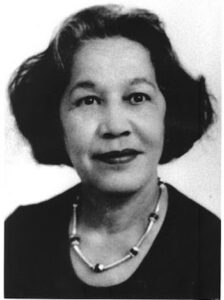We are happy to continue our series, Composers to Discover! featuring essays by students in the Public Musicology Certificate Program at Columbus State University, coordinated by Dr. Reba Wissner. Today’s essay is by Riley Bryan, a recent graduate of the Schwob School of Music, Columbus State Univ., receiving a BA in Music as well as a Public Musicology Certificate. Riley plans to attend Indiana University to pursue a Master of Arts in Arts Administration.
From Chicago Normal School to Juilliard: Irene Britton Smith’s rise to success (and eventual influence) — AND celebrating her birthday December 22!

Irene Britton Smith.
Photo credit, Center for Black Music Research in Columbia College, Chicago
Discover the captivating compositions of Irene Britton Smith (1907-1999), an extraordinary composer, educator, and musician! With more than 30 compositions to her name, including vocal works, piano and chamber pieces, as well as orchestral masterpieces, Smith’s musical legacy – once it becomes better known – will resonate in the hearts of music enthusiasts. Of African-American, Crow, and Cherokee descent, Irene Britton Smith became an established violinist, pianist, and organist, as well as working as an elementary educator. Born and raised in Chicago, IL, Britton Smith was the youngest of four siblings. In her youth, she quickly developed a passion for music and began piano lessons with V. Emanuel Johnson. Soon after that she started composing short pieces and taking violin lessons. After graduating from high school, she knew she wanted to pursue a music degree, but due to finances, she ended up attending the Chicago Normal School from 1924–1926, earning a degree in education. She worked as an elementary school teacher from 1930, and Smith remained passionate about music and continued her musical studies during her free time. She played violin in the all-Black Harrison Farrell Orchestra and in 1932, she became a part-time student at the American Conservatory of Music studying music theory with Stella Roberts and composition with Leo Sowerby. In 1943, Britton Smith earned a Bachelor of Music degree. Seeking to advance her composition abilities, she began studying composition at the Juilliard School of Music with Vittorio Giannini. She continued her composition studies at the Eastman School of Music and the Tanglewood Music Festival. In 1956, Britton Smith earned her Master of Music degree in composition at DePaul University in Indiana.
Irene Britton Smith composed dozens of works over her lifetime but she never considered herself a legitimate composer. She even went as far as saying “I’m too critical of my compositions, so I’m my own worst enemy.” Her main desire for composing was for her own personal satisfaction, so she didn’t do much to promote and publish her works. Despite Britton Smith being a violinist and pianist, 19 of her compositions were vocal works, composed for various groups including chorus, vocal ensemble, and solo voice with piano. Britton Smith also composed several works for piano, orchestra, violin, and one string trio. Britton Smith frequently composed and arranged spirituals as well as spiritual texts by poet Paul Laurence Dunbar. Inspired by her favorite French composers, César Franck (1822-1890) and Gabriel Fauré (1845-1924), Britton Smith’s compositional style sometimes resembles French neo-classical music. While taking a sabbatical at the Juilliard School of Music, Britton Smith composed her Sonata for Violin and Piano. The sonata is one of her best-known compositions. The piece was composed in 1947 and was premiered at the Dover Public Library in 1990 by violinist Gregory Walker and pianist Helen Walker-Hill. In 1995, the work was recorded and featured on the CD, Kaleidoscope; Music by African American Women, produced by Leonarda Records. That recording is here on Spotify, and there are also more recent recordings, such as this one with Caitlin Edwards and Daniel Schlosberg.
 Another important piece is Sinfonietta (1956). A Sinfonietta is a smaller-scale symphony in terms of instrumentation and length. Britton Smith composed her Sinfonietta as a thesis project for her masters degree. This piece sat on a shelf in archives until its premiere in November 2023 by the University of Colorado Boulder Symphony Orchestra under the direction of Kedrick Armstrong. Armstrong spent over a year arranging the parts from the original score to orchestra stating that “Immediately, [he] knew there was something in her language and in her writing that was different from anything that [he] had ever heard before, especially coming from a Black woman in the 20th century.” Sadly, Britton Smith never heard Sinfonietta performed before her death in 1999. The 20- minute-long piece consists of three movements (I) Moderato tranquillo – Allegro con moto, (II) Adagio, and (III) Energico – Animato.
Another important piece is Sinfonietta (1956). A Sinfonietta is a smaller-scale symphony in terms of instrumentation and length. Britton Smith composed her Sinfonietta as a thesis project for her masters degree. This piece sat on a shelf in archives until its premiere in November 2023 by the University of Colorado Boulder Symphony Orchestra under the direction of Kedrick Armstrong. Armstrong spent over a year arranging the parts from the original score to orchestra stating that “Immediately, [he] knew there was something in her language and in her writing that was different from anything that [he] had ever heard before, especially coming from a Black woman in the 20th century.” Sadly, Britton Smith never heard Sinfonietta performed before her death in 1999. The 20- minute-long piece consists of three movements (I) Moderato tranquillo – Allegro con moto, (II) Adagio, and (III) Energico – Animato.
From her well-known Sonata for Violin and Piano to the recent premiere of her Sinfonietta, Britton Smith’s works remain a testament to her legacy. The growing recognition of her compositions reminds us of the profound musical contributions that Irene Britton Smith contributed in her lifetime.
Sources: The main source on Irene Britton Smith remains the chapter on her in Helen Walker Hill’s book From Spirituals to Symphonies (Univ. of IL Press, 2002). The Africlassical.com website summarizes some of that material.
